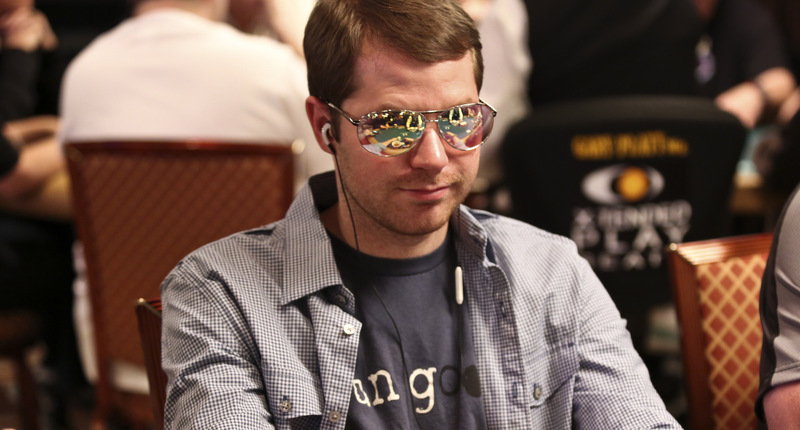






Calling An All-In With A Flush Drawby Jonathan Little | Published: Jun 22, 2016 |
|
|

Jonathan Little
With blinds at 400-800 ante 100, a tight aggressive player with 22,000 raised to 2,000 from first position. An unknown player in second position called 2,000 out of his 8,500-chip stack. The player in third position folded and Hero looked down at A K
K in the lojack seat. With a 24,000-chip stack, he decided to three-bet to 6,000.
in the lojack seat. With a 24,000-chip stack, he decided to three-bet to 6,000.
I am fine with this play, but I think both calling and pushing all in are fine alternatives. I usually shy away from three-betting tight against first position raisers because their range should be quite strong. If I do elect to three-bet, I usually want to go all in if my stack permits it, because if the initial raiser calls a three-bet to 6,000, I will usually be in only marginal shape and will have to invest significant money after the flop on most boards with a marginal holding. Also, if I happen to make top pair, my opponent will usually have an under pair that will fold to any aggression. If the initial raiser pushes all-in over a three-bet to 6,000, I am forced to make a reluctant call. I think that by going all-in instead of three-betting to 6,000, I force the initial raiser to fold many hands that have roughly 50 percent equity, which is a great result. Of course, I will be in marginal shape when I get called, but I think the times I pick up the pot preflop is worth the risk of getting it in slightly bad versus a range of A-A, K-K, Q-Q, J-J, and A-K.
Everyone folded around to the small blind, a tight passive player, who put in 2,000, not seeing the three-bet to 6,000. After putting in 2,000, he decided to put in 4,000 more, leaving 13,400 in his stack. The initial raiser folded and the player in second position called 4,000 more, leaving only 2,400 behind. At this point, it should be clear that both opponents almost certainly do not have premium hands. It is difficult to say exactly how wide their ranges are, but they almost certainly do not have A-A, K-K, Q-Q, J-J, or A-K.
The flop came 9 7
7 5
5 , giving Hero a flush draw and two overcards. The small blind pushed all in for 13,400 into the 21,700-chip pot and the player in second position called for his last 2,400. At this point, Hero has to call 13,400 to win 37,500, meaning he needs to win 26 percent of the time to justify calling. For all practical purposes, you can ignore the player in second position because his stack is so short that you are always getting the right price to call versus him.
, giving Hero a flush draw and two overcards. The small blind pushed all in for 13,400 into the 21,700-chip pot and the player in second position called for his last 2,400. At this point, Hero has to call 13,400 to win 37,500, meaning he needs to win 26 percent of the time to justify calling. For all practical purposes, you can ignore the player in second position because his stack is so short that you are always getting the right price to call versus him.
The player who posted this hand says he put the small blind on exactly a set. While I find it impossible to not think this player would also make this play with 10-10, 9 8
8 , and J
, and J 10
10 , let’s assume that he only has sets in his range. If he only has sets, your flush draw will win 25 percent of the time, meaning your decision is break-even. If he ever makes this play with the other hands, mainly overpairs, pairs plus straight draws, and flush draws, A
, let’s assume that he only has sets in his range. If he only has sets, your flush draw will win 25 percent of the time, meaning your decision is break-even. If he ever makes this play with the other hands, mainly overpairs, pairs plus straight draws, and flush draws, A K
K jumps up to 48 percent equity. Since, in reality, you are somewhere between 25 percent and 48 percent, you have a fairly easy call with A
jumps up to 48 percent equity. Since, in reality, you are somewhere between 25 percent and 48 percent, you have a fairly easy call with A K
K in this situation.
in this situation.
Most likely, the person who posted this hand lost the pot and then second-guessed himself as to whether or not he should have made a “big call” with a “drawing hand” for effectively his tournament life. It is mandatory you stop thinking of hands in terms of “draws” and “made hands” and instead look at how much equity you have. In order to excel at poker, you must get away from thinking in blanket terms and making huge generalizations as to what is acceptable play and what is not. Since many players have been taught by other amateur players to never call off their stack with a drawing hand, they assume this call must be suspect, whereas in reality, any play besides calling is almost certainly a huge error. Always take the time to analyze these situations away from the table so you know how to tackle them when they arise at the table. ♠
Jonathan Little is a two-time WPT champion with more than $6 million in tournament winnings. Each week, he posts an educational blog and podcast at JonathanLittlePoker.com, where you can get a FREE poker training video that details five things you must master if you want to win at tournament poker.
Features
The Inside Straight
Strategies & Analysis
Commentaries & Personalities